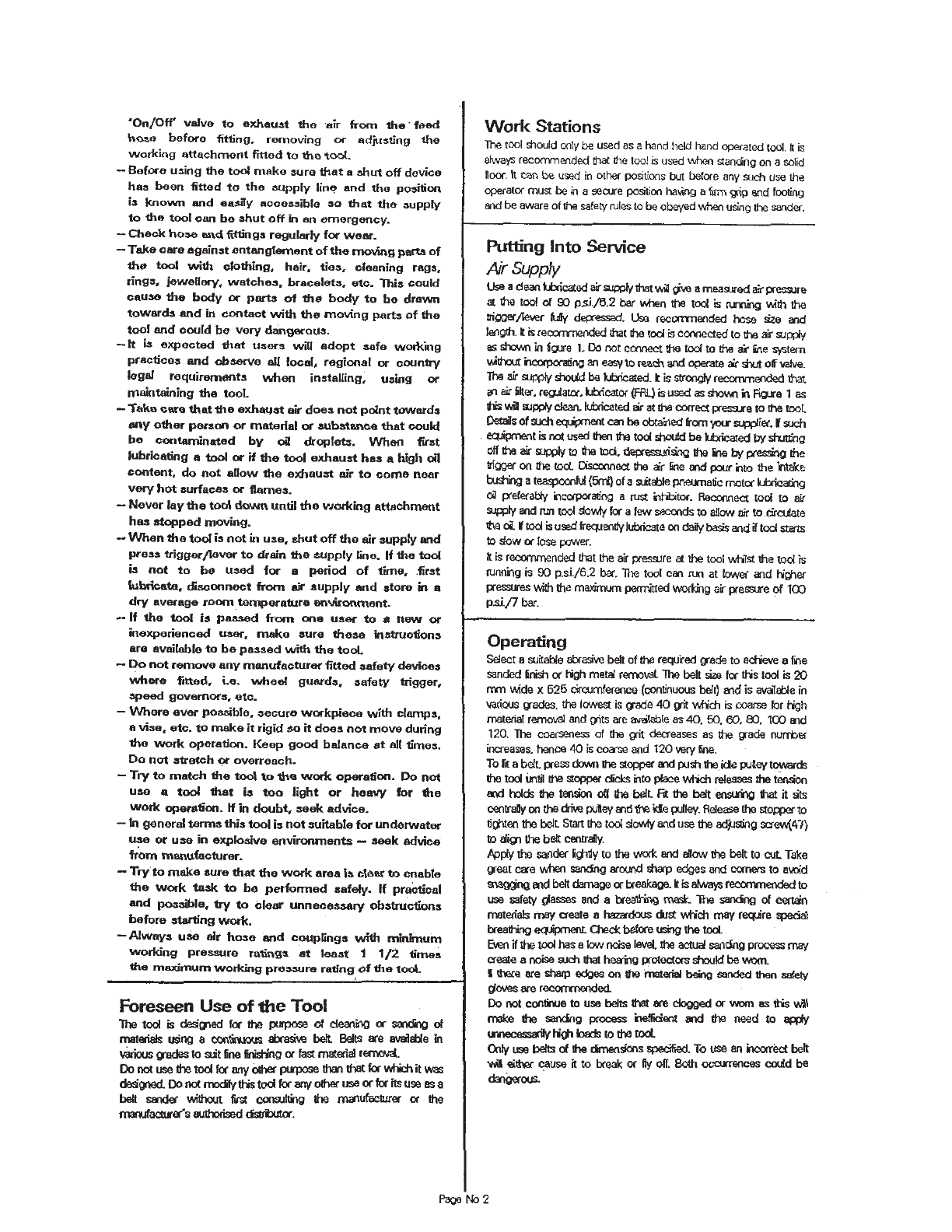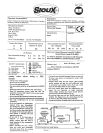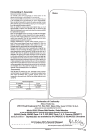
'On/Off
valve
to
exhaust
the
air
from
the¥fee
hose
before
fitting,
removing
or
adjusting the
working
attachment
fitted
to
the
tool.
-Before
using
the tool make sure
that
a
shut
off
device
has
been
fitted
to the supply line and the
position
13
known
and
easily
aaoeaaibia
SO
that
the
supply
to
the
tool
can
be
shut
off
in
an
emergency.
-
Chech
hose
and
fittings regularly
fa
wear.
-Take
care
against
entanglement
of
the
moving
pans
of
the tool
whh
clothing, hair, ties, cleaning
rags,
rings, jewellery, watches, bracelets,
etc.
This
could
cause the
body
or
parts
of
the
body
to
be
draw
towards
and
in
contact
with
the
moving
parts
of
the
tool
and
could be very dangerous.
-ft
is
expected
that
users
will
adopt safe
wolkmg
practices
and
observe
all
local, regional
or
country
legal requirements
when
installing. using
or
maintaining
the
tool.
-
Taka
care that the
exhayat
air
does
not
point
towards
any
other
person
or material
or
aubstanee
that
could
be
contaminated
by
oil
droplets.
When
first
lubricating
a
tool
a
if
the tool exhaust
has
a
high
oil
content, do not allow the exhaust
air
to
come near
very
hot
surfaces
or
flames.
-
Never lay
the
tool down until
the
v~~tking
attachment
has
stopped moving.
-When
the
tool
is
not
in
use, shut
off
the
air
supply
and
MOSS
triggerfiver
to
drain
the supply he.
If
the
tool
is
not
to be
used
for
a
period
of
time,
first
kibricata,
disconnect
from
air
supply
and
store
in
a
dry
average
room
temperature
environment.
-If
the
tool
is
passed
from
one
user
to
8
new
or
inexperienced usw, make sure these instructions
are available to
be
passed
with
the tod.
-
Do
not
remove any manufacturer
fitted
safety
devices
where
fitted,
1.0.
wheel guards,
safety
trigger,
speed
governors, etc.
-
Where ever possible,
secure
wofkpiece
with
clamps,
a
vise, etc. to
make
it
rigid
so
it
does not move
during
the work operation.
Keep
good
balance at all times.
Do
not
stretch
or
overreach.
-Try
to
match
the
tool
to
the
work
operation.
Do
not
use
a
tool
that
is
too
light
or heavy
for
the
work
operation.
If
in
doubt,
aeek
advice.
-In
general
terms
this
tool
is
not
suitable
for
underwater
use
or
use
In
explosive environments
-
seek
edvice
from
manufacturer.
-
Tryto
make
sure
that
the work area
is
clear
to
enable
the
work
task
to
be
perfomnad
safely.
If
practical
and
possible,
try
to
clear
unnecessary
obstructions
before
starling
work.
-Always
use
air
hose
and
couplings
wMi
minimum
working
pressure ratings at
least
1
112
tunas
the
maximum
working pressure rating of
the
tool.
Foreseen
Use
of
the
Tool
The
tod!
is
designed
for
tha
purpose
of
cleaning
or
sanding
of
materials
using
a
continuous
abrasive
beh.
Belts
are
available
in
v&om
grades
to
ait
fine
finislwg
or
fast
materid
removal.
Do
not
use
the
tool
for
any
dher
purpose
than
that
for
which it
was
degned.
Do
not
modify
this
tod
for
am
other
use
or
for
its
use
as
a
belt
saxkr
without
fira
consultho
the
manufacturer
or
the
manufacturersauthoriseddaributor.
Work
Stations
The
tool should
only
be
used
as
a
hand
held
hand
operated
too),
li
is
always
recormended
hat
he
too!
is
used
when
standing
on
a
solid
floor.
It
can
be
used
in
other
positions
but
before
any
such
use
the
operator
must
be
in
a
secure
position
haMng
a
(inn
gip
and
footing
and
be
aware
olh
safety
rules
to
be
obeyed
when
using
the
sander.
Putting
Into
Service
Air
Supp/y
Use
a
dean
fufcricated
air
supply
that
wit
ow
a
measured
air
pressure
at
the
loo)
of
90
pd.B.2
bar
when
the
tool
is
running
wih
the
m'ooef/lever
My
dqxessed.
Usa
recommended
hcse
size
and
lengih.
It
is
recommended
that
the
tool
is
connected
to
the
air
supply
asshewnhfgure
1-Donotconnectihotooltotheairhesystem
vçithou
incoporaB'no
an
easy
to
reach
and
operate
air
dwt
off
lalve.
The
a!f
supply
should
be
lubricated.
k
is
strawly
recommended
that
a\
at
ilta-.
rmator.
lubricator
(FPL1
is
used
as
show)
in
fiaire
1
as
tvs
wH
sup&
dean.
lubricated
&
at
IIW
correct
presaura
to
(ha
mL
Oetalsof
such
equipment
can
ba
obtained
from
wur
supplier.
1
such
equipment
is
no!
used
(hen
lha
tool
should
be
lubricated
by
shutting
~fflhaairsupply~lhatod.depress~n.~thefnebypressingthe
(rigger
on
the
tool
Disconnect
the
ar
he
aid
pour
into
the
intake
bJshira
a
teaspconfu!
(5n-d)
of
a
suitable
pneumatic
motor
lubricating
oil
pefefat*/
incofpofiiiiq
a
rust
htih'tw.
Reconnect
tool
to
air
wty
and
run
tool
do*
for
a
few
seconds
to
allow
air
to
circulate
(he
oL
If
tool
is
used
frequentfylubricate
on
daily
baas
and
if
tool
starts
to
dow
or
lose
power.
It
is
recommended
that
tbe
air
pressure
at
the
tool
whist
the
tool
is
(unning
is
90
p.si/6.2
baf.
k
tool
can
run
at
lower
and
l-igher
pressures
with
the
rn-
permitted
working
air
pressure
of
100
psi./7
bar.
Operating
Select
a
suitable
abrasive
belt
of
the
required
grade
to
acrteve
a
fine
sanded
inish
or
tigh
metal
removal.
The
belt
size
for
tMs
tool
is
20
mm
vide
K
526
ciccumfefence
(continuous
belt)
and
is
available
in
various
grades.
the
lowest
is
grade
40
grit
which
is
coarse
for
high
material
removal
and
grits
are
available
as
40.50.60.80.
100
ad
120.
The
coarseriess
of
Una
grit
decreases
as
the
grade
number
increases.
hence
40
is
coarse
and
120
wy
fine.
To
lit
a
belt.
press
down
Die
stopper
aid
push
lha
idle
puley
towards
(he
tool
until
the
stopper
clicks
into
place
which
releases
the
tension
aid
holds
(he
tension
off
(he
bdL
Fit
the
belt
ensuring
lhat
it
sits
centrally
on
the
drive
pulley
and
the
*He
pulley.
Release
tho
stopper
to
lighten
the
belt
Start
the
tool
dW
and
use
the
adjusting
screw{47)
to
dig^
the
belt
centray.
&ply
the
sanda-
i&Uy
to
the
work
and
allow
the
bek
to
cut
Take
great
care
when
sanding
around
sharp
edges
and
comers
to
avoid
snaggng
and
belt
damage
or
breakage.
It
is
always
recommended
to
use
safety
glasses
and
a
breathing
mask.
"Rle
sandng
of
certain
materials
may
aeate
a
hazardous
dust
Wdi
may
r@re
breathing
equipment.
Check
before
using
(he
tool.
Even
if
Ihe
tool
has
a
low
noise
level.
the
actual
sandma
process
vrw
aeate
a
noise
such
that
hearing
protectors
should
be
warn.
f
there
are
shalp
edges
on
the
material
being
sanded
ihen
safety
doves
are recommended.
Do
not
continue
to
use
belts
that
are
dogged
or
vmm
as
this
will
make
(he
sanding
process
*nefficient
and
(he
need
to
apcfr
unnecessarily
high
loads
to
the
tool.
Only
use
belts
of
the
dimensions
specified.
To
use an
incorrect
belt
vdl
either
cause
it
to
break
or
fly
off.
Both
occurences
could
be






